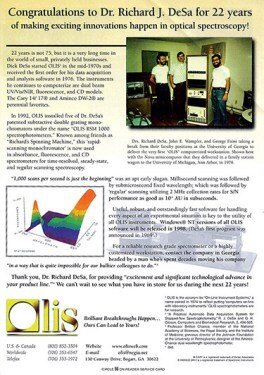Facts About Uv/vis Uncovered
Facts About Uv/vis Uncovered
Blog Article
The Circular Dichroism PDFs
Table of ContentsRumored Buzz on Circularly Polarized LuminescenceThe Greatest Guide To Uv/vis/nirThe Definitive Guide for Circular DichroismAll about Uv/vis/nirOur Uv/vis/nir PDFsSome Known Details About Circularly Polarized Luminescence Not known Incorrect Statements About Uv/vis The Spectrophotometers IdeasThe Spectrophotometers IdeasAbout Circular DichroismEverything about Circular DichroismA Biased View of Uv/visThe Best Strategy To Use For Circular Dichroism
It is then scanned through the sample and the referral services. Portions of the occurrence wavelengths are transferred through, or shown from, the sample and the referral. The resultant light strikes the photodetector gadget, which compares the relative strength of the 2 beams. Electronic circuits transform the relative currents into linear transmission portions and/or absorbance/concentration worths.The transmission of a reference compound is set as a standard (information) value, so the transmission of all other substances are taped relative to the initial "zeroed" compound. The spectrophotometer then converts the transmission ratio into 'absorbency', the concentration of particular components of the test sample relative to the initial compound.
Considering that samples in these applications are not readily available in large amounts, they are especially matched to being examined in this non-destructive technique. In addition, precious sample can be saved by using a micro-volume platform where just 1u, L of sample is required for complete analyses. A brief explanation of the treatment of spectrophotometry consists of comparing the absorbency of a blank sample that does not consist of a colored substance to a sample that contains a colored compound.
Getting The Circularly Polarized Luminescence To Work
In biochemical experiments, a chemical and/or physical residential or commercial property is picked and the procedure that is utilized specifies to that residential or commercial property in order to derive more details about the sample, such as the quantity, purity, enzyme activity, and so on. Spectrophotometry can be utilized for a number of strategies such as identifying optimum wavelength absorbance of samples, determining optimal p, H for absorbance of samples, identifying concentrations of unidentified samples, and determining the p, Ka of different samples.: 21119 Spectrophotometry is likewise a useful procedure for protein purification and can also be used as an approach to develop optical assays of a compound.
It is possible to understand the concentrations of a two part mix using the absorption spectra of the standard services of each part. To do this, it is essential to know the termination coefficient of this mix at 2 wave lengths and the termination coefficients of options which contain the known weights of the two elements.

The 15-Second Trick For Uv/vis/nir
Region. The concentration of a protein can be estimated by determining the OD at 280 nm due to the existence of tryptophan, tyrosine and phenylalanine.
Nucleic acid contamination can likewise interfere. This technique needs a spectrophotometer efficient in measuring in the UV region with quartz cuvettes.: 135 Ultraviolet-visible (UV-vis) spectroscopy includes energy levels that delight electronic transitions. Absorption of UV-vis light excites particles that are in ground-states to their excited-states. Noticeable region 400700 nm spectrophotometry is used thoroughly in colorimetry science.
20. 8 O.D. Ink producers, printing companies, fabrics vendors, and lots of more, require the data supplied through colorimetry. They take readings in the region of every 520 nanometers along the noticeable region, and produce a spectral reflectance curve or an information stream for alternative presentations. These curves can be used to test a new batch of colorant to examine if it makes a match to specs, e.
See This Report on Circularly Polarized Luminescence
Conventional visible area spectrophotometers can not find if a colorant or the base material has fluorescence. This can make it difficult to handle color issues if for instance several of the printing inks is fluorescent. Where a colorant contains fluorescence, a bi-spectral fluorescent spectrophotometer is utilized (https://pagespeed.web.dev/analysis/https-olisclarity-com/ft59obxjpp?form_factor=mobile). There are 2 major setups for visual spectrum spectrophotometers, d/8 (round) and 0/45.
Researchers use this instrument to determine the quantity of compounds in a sample. In the case of printing measurements two alternative settings are typically used- without/with uv filter to control much better the effect of uv brighteners within the paper stock.
Uv/vis Fundamentals Explained
Some applications need small volume measurements which can be performed with micro-volume platforms. As described in the applications section, spectrophotometry can be utilized in both qualitative and quantitative analysis of DNA, RNA, and proteins. Qualitative analysis can be used and spectrophotometers are used to record spectra of compounds by scanning broad wavelength areas to determine the absorbance homes (the strength of the color) of the substance at each wavelength.

Some Known Details About Spectrophotometers
One major aspect is the kind of photosensors that are offered for different spectral regions, but infrared measurement is likewise tough due to the fact that virtually whatever emits IR as thermal radiation, especially at wavelengths beyond about 5 m. Another complication is that quite a couple of products such as glass and plastic absorb infrared, making it incompatible as an optical medium.
Retrieved Dec 23, 2018. Fundamental Laboratory Techniques for Biochemistry and Biotechnology (2nd ed.). The necessary guide to analytical chemistry.
Chichester, NY: Wiley. pp. 1617. ISBN 9780471974123. OCLC 36543293. Ninfa AJ, Ballou DP (2004 ). Basic laboratory approaches for biochemistry and biotechnology. Hoboken: Wiley. p. 66. ISBN 9781891786006. OCLC 633862582. Rendina G (1976 ). Philadelphia, PA: W. B. Saunders Business. pp. 46-55. ISBN 0721675506. OCLC 147990. Oke, J. B.; Gunn, J. E.
The smart Trick of Uv/vis/nir That Nobody is Discussing
"Secondary basic stars for outright spectrophotometry". The Astrophysical Journal. 266: 713. Bibcode:1983 Ap, J..266..713 O. doi:10. 1086/160817. Ishani, G (2006 ). "The very first industrial UV-vis spectrophotometer". p. 100. Retrieved Dec 23, 2018. Simoni, RD; Hill, RL; Vaughan, M; Tabor, H (Dec 5, 2003). "A Classic Instrument: The Beckman DU Spectrophotometer and Its Creator, Arnold O.
278 (49 ): e1. doi:. ISSN 1083-351X. Beckman, A. O.; Gallaway, W. S.; Kaye, W.; Ulrich, W. F. (March 1977). "History of spectrophotometry at Beckman Instruments, Inc". Analytical Chemistry. 49 (3 ): 280A300A. doi:10. 1021/ac50011a001. "Hewlett Packard: Compound Recognition with HP 8450 A UV Noticeable Spectrophotometer". Analytical Chemistry. 51 (12 ): 1188A1189A. 1979-10-01.
1021/ac50048a728. ISSN0003-2700. Ninfa AJ, Ballou DP, Benore M (2015 ). Basic Laboratory Techniques for Biochemistry and Biotechnology (3, rev. ed.). Hoboken, NJ: Wiley & Sons. p. 77. ISBN9780470924525. OCLC915641828. "Fully Automatic Double Beam - Atomic Absorption Spectrophotometer (AA 8000)". Laboratory Devices. Labindia Analytical Instruments Pvt. Ltd. "Spectrophotometry Applications and Fundamentals".
Uv/vis Fundamentals Explained
Obtained Jul 4, 2018. Trumbo, Toni A.; Schultz, Emeric; Borland, Michael G.; Pugh, Michael Eugene (April 27, 2013). "Applied Spectrophotometry: Analysis of a Biochemical Mix". Biochemistry and Molecular Biology Education. 41 (4 ): 24250. doi:10. 1002/bmb. 20694. PMID 23625877. (PDF). www. mt.com. Mettler-Toledo AG, Analytical. 2016. Obtained Dec 23, 2018. Cortez, C.; Szepaniuk, A.; Gomes da Silva, L.
"Exploring Proteins Filtration Strategies Animations as Tools for the Biochemistry Mentor". Journal of Biochemistry Education. 8 (2 ): 12. doi:. Garrett RH, Grisham CM (2013 ). Biochemistry. Belmont, CA: Cengage. p. 106. ISBN 978-1133106296. OCLC 801650341. Holiday, Ensor Roslyn (May 27, 1936). "Spectrophotometry of proteins". Biochemical Journal. 30 (10 ): 17951803. doi:10. 1042/bj0301795.
PMID 16746224. Hermannsson, Ptur G.; Vannahme, Christoph; Smith, Cameron L. C.; Srensen, Kristian T.; Kristensen, Anders (2015 ). "Refractive index dispersion noticing using a range of photonic crystal resonant reflectors". Applied Physics Letters. 107 (6 ): 061101. Bibcode:2015 Ap, Ph, L. 107f1101H. doi:10. 1063/1. 4928548. S2CID 62897708. Mavrodineanu R, Schultz JI, Menis O, eds.
8 Simple Techniques For Circularly Polarized Luminescence
U.S. Department of Commerce National Bureau of Standards special publication; 378. Washington, D.C.: U.S. National Bureau of Standards. p. 2. OCLC 920079.
The procedure starts with a controlled source of light that brightens the analyzed sample. When it comes to reflection, as this light connects with the sample, some is soaked up or emitted. The discharged light journeys to the detector, which is examined, quantified, and presented as industry-standard color scales and indices.
All terms are examined over the visible spectrum from 400 to 700 nm. In the case of transmission, when the light connects with the sample, it is either taken in, reflected, or transferred.
An Unbiased View of Circularly Polarized Luminescence
Examples include APHA (American Public Health Association) for watercolor and purity analysis, ASTM D1500 for petrochemical color analysis, edible oil indices utilized in food, and color analyses of drinks. All terms are assessed over the visible spectrum from 400 to 700 nm.
Image Credit: Matej Kastelic/ Dr. Arnold J. Beckman and his colleagues at the National Technologies Laboratories first Web Site invented the spectrophotometer in 1940. In 1935 Beckman established the company, and the discovery of the spectrophotometer was their most ground-breaking development.
The Single Strategy To Use For Uv/vis
Over time, researchers kept improving the spectrophotometer style to enhance its performance. The UV abilities of the design B spectrophotometer were improved by replacing the glass prism with a quartz prism.
Usually, a spectrophotometer is made up of two instruments, particularly, a spectrometer and a photometer. A basic spectrophotometer consists of a light source, a monochromator, a collimator for straight light beam transmission, a cuvette to place a sample, and a photoelectric detector.
The smart Trick of Circular Dichroism That Nobody is Discussing
There are different types of spectrophotometers in different shapes and sizes, each with its own purpose or performance. A spectrophotometer figures out how much light is reflected by chemical parts. UV/Vis. It determines the distinction in light strength based on the total quantity of light introduced to a sample and the quantity of beam that travels through the sample solution
Based on the instrument's style, the sample is positioned between the spectrometer and the photometer. After the light is gone through the sample, the photometer measures its intensity and displays the reading. A spectrophotometer is utilized to identify the concentration of both colorless and colored solutes in a service. This instrument is used to determine the rate of a reaction.
Report this page